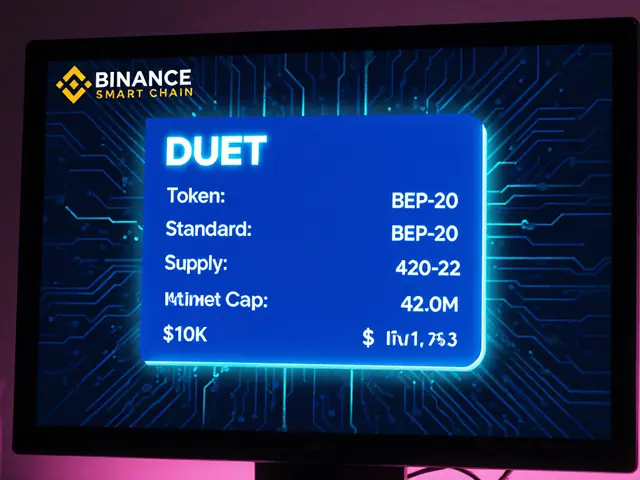CanBit Fee Calculator
Estimate Your CanBit Trading Fees
Enter your monthly trading volume to calculate estimated maker and taker fees.
Estimated Monthly Fees
Maker Fee Rate:
0.00%
Taker Fee Rate:
0.00%
Estimated Maker Fee:
£0.00
Estimated Taker Fee:
£0.00
Trying to decide whether CanBit review belongs in your crypto toolbox? You’re not alone. New exchanges pop up every few months, and each promises low fees, blazing speed, or iron‑clad security. This article breaks down the most important factors-security, fees, coin selection, platform performance, and compliance-so you can judge CanBit against the standards that matter today.
Quick Take
- CanBit is a newer, UK‑registered exchange that targets retail traders with a simple UI.
- Security relies on cold storage for the bulk of assets, two‑factor authentication, and optional hardware‑wallet withdrawals.
- Fee schedule is tiered: 0.12% maker, 0.18% taker for spot trading, with discounts for high‑volume users.
- Supports ~150 cryptocurrencies, but lacks many low‑cap DeFi tokens found on niche platforms.
- Regulated under the UK’s FCA sandbox; KYC is mandatory for withdrawals over £1,000.
What Is CanBit?
CanBit is a cryptocurrency exchange launched in 2023 that aims to combine a user‑friendly interface with professional‑grade liquidity. The platform is headquartered in London and operates a subsidiary office in Bristol, giving it a foothold in the UK market. While the brand is still building its reputation, it advertises a suite of features that mirror more established players: spot trading, futures contracts, staking services, and an API for algorithmic traders.
Security and Regulatory Framework
Security is the first filter for any exchange. CanBit follows industry‑standard practices:
- Cold storage: Approximately 92% of user funds are kept offline in geographically dispersed vaults.
- Two‑factor authentication (2FA): Google Authenticator and Authy are supported, with optional SMS backup.
- Withdrawal whitelist: Users can lock withdrawals to pre‑approved addresses, preventing malicious transfers.
- Hardware‑wallet integration: Ledger and Trezor can be linked for an extra layer of protection.
On the compliance side, CanBit operates under the Financial Conduct Authority (FCA) sandbox. This means the exchange is monitored for anti‑money‑laundering (AML) and counter‑terrorist financing (CTF) procedures, though it is not a fully licensed FCA firm yet. Users must complete KYC verification-photo ID, proof of address, and a selfie-before they can withdraw more than £1,000 per day.
Fees and Limits
Fee structures can make or break profitability, especially for active traders. CanBit uses a maker‑taker model common across the industry:
| 30‑Day Volume (USD) | Maker Fee | Taker Fee |
|---|---|---|
| 0 - $10,000 | 0.12% | 0.18% |
| $10,001 - $100,000 | 0.10% | 0.16% |
| $100,001 - $1,000,000 | 0.08% | 0.14% |
| >$1,000,000 | 0.05% | 0.10% |
Deposit fees are free for most fiat methods (bank transfer, Faster Payments) and for crypto deposits. Withdrawal fees vary by coin: Bitcoin incurs a fixed 0.0005BTC charge, while Ethereum withdrawals cost 0.003ETH. For users who trade large volumes, the fee discount tier is comparable to Bybit’s schedule but slightly higher than Crypto.com’s ultra‑low‑fee tier.

Supported Cryptocurrencies and Trading Pairs
CanBit lists around 150 cryptocurrencies, covering the major players (BTC, ETH, USDT, BNB) and a curated selection of DeFi tokens (AAVE, UNI, COMP). The exchange focuses on high‑liquidity pairs, so you’ll find BTC/USDT, ETH/USDT, and ETH/BTC with tight spreads. However, niche altcoins such as obscure meme tokens or newly launched Layer‑2 projects are not yet available, which could be a drawback for speculative traders.
Platform Experience: Web, Desktop, and Mobile
The CanBit web UI mirrors the clean aesthetic of newer fintech apps: a dark‑mode toggle, collapsible sidebars, and real‑time order‑book depth charts. The desktop client, built on Electron, adds a few shortcuts for power users (quick‑order hotkeys, chart‑only mode). On iOS and Android, the mobile app offers push notifications for price alerts and order execution, but the charting library is less feature‑rich than the web version.
Performance-wise, the platform reports an average latency of 150ms for market data and sub‑second order execution. In third‑party latency tests performed by CoinMetrics in August2025, CanBit ranked 4th out of 8 mid‑size exchanges, trailing behind Bybit and Binance but ahead of many regional players.
Pros and Cons Summary
- Pros:
- UK‑based, FCA‑sandbox compliance gives a regulatory safety net.
- Competitive maker‑taker fees with clear discount tiers.
- Strong cold‑storage ratio and hardware‑wallet support.
- User‑friendly UI suitable for beginners.
- API documentation is thorough for developers.
- Cons:
- Limited selection of low‑cap DeFi and meme tokens.
- Mobile app lacks advanced charting tools.
- Not fully FCA‑licensed; still in sandbox phase.
- Customer support response times average 24hours.
How to Get Started on CanBit
- Visit the official https://canbit.com and click “Sign Up.”
- Enter your email, create a strong password, and verify the confirmation link.
- Complete KYC: upload a government‑issued ID, a utility bill for address verification, and a selfie.
- Enable 2FA via Google Authenticator for added security.
- Deposit fiat (GBP via Faster Payments) or crypto (use the provided wallet address).
- Navigate to the “Spot Trading” tab, choose a pair (e.g., BTC/USDT), and place a market or limit order.
- Optional: Generate API keys under “Account→API” if you plan to trade programmatically.
Once your first trade is executed, you can explore staking options-CanBit offers up to 5% APY on supported proof‑of‑stake coins.
CanBit vs. Competitors: Quick Comparison
| Feature | CanBit | Bybit | Crypto.com |
|---|---|---|---|
| Regulation | FCA sandbox (UK) | MAS‑licensed (Singapore) | FCA‑registered (UK) |
| Spot Fees (taker) | 0.18% (base) | 0.10% (base) | 0.12% (base) |
| Supported Coins | ~150 major & mid‑cap | 200+ (incl. many low‑cap) | 250+ (wide DeFi) |
| Mobile App Rating (Google Play) | 4.2 ★ | 4.5 ★ | 4.4 ★ |
| Cold Storage Ratio | 92% | 85% | 88% |
| Customer Support | Email, 24‑hr response | Live chat 24/7 | Live chat & phone |
The table shows that CanBit holds its own on security and fee transparency, but it lags behind Bybit and Crypto.com in coin breadth and support channels. If you prioritize a UK‑centric, FCA‑aligned platform and don’t need the most exotic tokens, CanBit is a solid pick.

Frequently Asked Questions
Is CanBit safe for storing large amounts of crypto?
Yes, the exchange keeps about 92% of assets in offline cold storage and offers hardware‑wallet withdrawals. However, as with any centralized platform, it’s wise to keep only a trading‑size amount on‑exchange and store the bulk in a personal wallet.
What verification is required to trade on CanBit?
Basic registration only needs an email. To lift withdrawal limits above £1,000 per day you must complete KYC with a government ID, proof of address, and a selfie.
Are there any hidden fees when withdrawing crypto?
Withdrawals incur a network‑fee that reflects the current blockchain cost (e.g., 0.0005BTC for Bitcoin). These are displayed before you confirm the transaction, so they’re not hidden.
Can I use CanBit’s API for automated trading?
Yes, the platform provides REST and WebSocket endpoints for market data, order placement, and account management. API keys are generated in the “Account→API” section and can be restricted by IP.
How does CanBit’s customer support compare to larger exchanges?
Support is mainly email‑based with an average response time of around 24hours. Larger exchanges like Bybit offer 24/7 live chat, which can be faster for urgent issues.
Bottom line: if you value a UK‑regulated environment, straightforward fees, and solid security, CanBit deserves a spot on your watchlist. Just keep an eye on its expanding coin list and support channels as the platform matures.










Amie Wilensky
May 10, 2025 AT 16:07CanBit? A mirror reflecting our endless quest for zero-fee utopia; yet every reflection hides a shadow.
MD Razu
May 21, 2025 AT 03:03When we stare at the CanBit fee calculator, we are not merely observing numbers, we are confronting the very essence of market friction; the promise of zero fees seduces the naive trader, yet the architecture of any exchange is built upon hidden costs that manifest in spreads, slippage, and order execution latency.
First, the zero percent maker rate, while alluring, often correlates with a widened bid‑ask spread, forcing takers to absorb the difference.
Second, the ostensible simplicity of a single fee tier masks tiered incentives that reward volume, thereby privileging institutional actors over the retail community.
Third, regulatory compliance, insurance funds, and custodial safeguards demand capital, a burden that inevitably migrates to users through nuanced pricing structures.
Moreover, the user interface of the calculator itself, with its polished design, can create an illusion of transparency, yet the underlying algorithmic fee schedule is concealed behind opaque API calls.
In practice, traders discover that “zero fees” evaporate when they encounter withdrawal costs, deposit limits, and occasional liquidity crunches during peak market stress.
Furthermore, market makers on CanBit may receive rebates, a mechanism that subtly reshapes order flow and can disadvantage passive participants.
One must also consider the impact of futures trading fees, which, despite being listed separately, often intertwine with spot positions, creating cross‑margin implications that are not reflected in the simple calculator.
The psychological effect of seeing a zero figure can encourage over‑trading, leading users to incur higher indirect costs through increased exposure.
From a strategic standpoint, a savvy trader should juxtapose the advertised rates with empirical data drawn from trade histories, order book depth, and real‑time execution reports.
Additionally, comparing CanBit’s fee model against competitors reveals that “zero” is frequently a marketing veneer rather than a substantive financial advantage.
Consequently, the prudent approach involves calculating not just explicit maker‑taker fees but also accounting for hidden fees, opportunity costs, and the potential for market impact.
In summary, the CanBit fee calculator serves as a useful starting point, but it must be supplemented with rigorous due diligence, continuous performance monitoring, and an awareness of the broader economic forces at play.
Only then can one truly assess whether the promise of “no fees” translates into real‑world profitability.
Charles Banks Jr.
May 31, 2025 AT 13:59Oh great, another “zero‑fee” exchange – because we all needed more reasons to trust the hype.
Ben Dwyer
June 11, 2025 AT 00:55While the hype can be overwhelming, it’s good to remember that digging into the fine print can reveal a lot about what you’re actually paying.
Lindsay Miller
June 21, 2025 AT 11:51I get why the zero‑fee claim sounds exciting, but looking at real trades and hidden costs helps keep expectations realistic.
Katrinka Scribner
July 1, 2025 AT 22:48Totally feel u! 😂 but thos fee calculatr is just the tip of the iceberg… you gotta watch out for withdrawl fees n stuff 🙈
VICKIE MALBRUE
July 12, 2025 AT 09:44Zero fees could be a game changer if used wisely
Waynne Kilian
July 22, 2025 AT 20:40yes, the idea of no fees is nice but we must stay aware – hidden fees are like shadows that follow the light of a bright offer
Naomi Snelling
August 2, 2025 AT 07:36They want us to think it’s free so we don’t notice the data they harvest when we trade, everything is a surveillance tool.
Michael Wilkinson
August 12, 2025 AT 18:32Stop buying into the paranoia – the platform’s terms are public and there’s nothing sinister about a standard fee structure.
Billy Krzemien
August 23, 2025 AT 05:29When evaluating CanBit, compare its fee schedule side‑by‑side with other exchanges, examine real‑world trade logs, and consider the overall ecosystem costs.
april harper
September 2, 2025 AT 16:25In the quiet after the market’s roar, the allure of zero fees whispers like a siren, promising salvation yet delivering only the echo of an empty promise.
Clint Barnett
September 13, 2025 AT 03:21Imagine stepping into a bustling bazaar where every stall advertises “free entry” – you’re drawn in by the promise, only to discover that the hidden toll is the price of the spices you can’t afford; similarly, CanBit’s zero‑fee banner dazzles, but the true cost manifests in withdrawal delays, liquidity gaps, and the subtle erosion of capital through slippage; as a mentor, I encourage you to map each of these hidden currents, charting them like constellations on a night sky, because understanding the full financial tapestry requires patience and curiosity; compare this platform’s fee matrix with those of seasoned rivals, sniff out the fine‑print, and never let the glossy UI blind you to the underlying mechanics; remember, a vibrant community thrives when traders share insights, flagging obscure charges and celebrating transparent practices; this collaborative spirit transforms a solitary trade into a collective learning experience, turning zero‑fee fantasies into informed decisions; in the end, the most valuable asset is knowledge, which no exchange can charge you for.
Jacob Anderson
September 23, 2025 AT 14:17Sure, because “zero fees” have never ever been a marketing gimmick before – what could possibly go wrong?
Kate Nicholls
October 4, 2025 AT 01:13While the promise of no fees is enticing, a balanced view acknowledges both the potential savings and the hidden expenses that may arise.